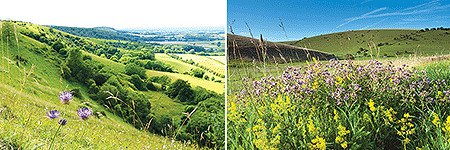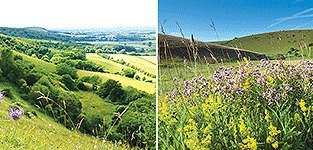April Susscx Wildlife Trust: The South Downs
April 1st, 2024 It only feels like yesterday (well, about 6,500 years ago) that we humans showed up and got to work.
It only feels like yesterday (well, about 6,500 years ago) that we humans showed up and got to work.I love heading out at the weekends for a hike over the Downs - but 90 million years ago, this part of the planet wouldn’t have been a safe place to be. I’d have been busy avoiding the teeth of hungry aquatic predators like the 10-metre-long Mosasaurs as I cruised through a shallow sea.
But it would be much smaller, less fearsome prehistoric organisms that would shape Sussex. The calcium shells from microscopic marine algae slumped to the sea floor and millions of years of pressure and erosion moulded them into the curvaceous chalk hills that form the familiar foundations of the South Downs.
It only feels like yesterday (well, about 6,500 years ago) that we humans showed up and got to work. The wild Sussex woods were chopped down and eventually sheep grazing became the dominant activity, on the cleared hills, for many centuries. The sheep-nibbled short downland turf is an internationally rare habitat, rich in flowers and the creatures that depend on them.
And, as chalk downland is such a rare habitat, the species that live here are also uncommon. Our butterflies are a prime example. Species like the Grayling, Silver-spotted Skipper, Small Blue, Adonis Blue and Chalk Hill Blue are restricted to this special habitat.
But it’s not just wildlife that benefits. Those porous chalk hills filter, store, and provide us with most of our water. They also offer loads of other free services from flood prevention to pollination and food production. The open countryside around Sussex also offers us immeasurable physical, mental and spiritual benefits. The South Downs were designated a National Park in 2011.
While writing this article, I discovered a letter penned in 1915 by the Lewes naturalist, W. E. Nicholson, expressing concern for the future of the South Downs around Lewes, and especially the rare Adonis Blue butterfly and scarce Forester Moth that live there. I’d like to think that Mr. Nicholson would be re-assured to know that, more than a century later, his beloved Lewes Downs, butterflies and moths are still just where he left them and all flourishing under the care of Sussex Wildlife Trust on their reserves at Malling Down and Southerham.
By Michael Blencowe: Learning & Engagement Officer, Sussex Wildlife Trust.
Sussex Wildlife Trust is an independent registered charity caring for wildlife and habitats throughout Sussex. It’s easy to join online at:
www.sussexwildlifetrust.org.uk/join
or T: 01273 497532
But it would be much smaller, less fearsome prehistoric organisms that would shape Sussex. The calcium shells from microscopic marine algae slumped to the sea floor and millions of years of pressure and erosion moulded them into the curvaceous chalk hills that form the familiar foundations of the South Downs.
It only feels like yesterday (well, about 6,500 years ago) that we humans showed up and got to work. The wild Sussex woods were chopped down and eventually sheep grazing became the dominant activity, on the cleared hills, for many centuries. The sheep-nibbled short downland turf is an internationally rare habitat, rich in flowers and the creatures that depend on them.
And, as chalk downland is such a rare habitat, the species that live here are also uncommon. Our butterflies are a prime example. Species like the Grayling, Silver-spotted Skipper, Small Blue, Adonis Blue and Chalk Hill Blue are restricted to this special habitat.
But it’s not just wildlife that benefits. Those porous chalk hills filter, store, and provide us with most of our water. They also offer loads of other free services from flood prevention to pollination and food production. The open countryside around Sussex also offers us immeasurable physical, mental and spiritual benefits. The South Downs were designated a National Park in 2011.
While writing this article, I discovered a letter penned in 1915 by the Lewes naturalist, W. E. Nicholson, expressing concern for the future of the South Downs around Lewes, and especially the rare Adonis Blue butterfly and scarce Forester Moth that live there. I’d like to think that Mr. Nicholson would be re-assured to know that, more than a century later, his beloved Lewes Downs, butterflies and moths are still just where he left them and all flourishing under the care of Sussex Wildlife Trust on their reserves at Malling Down and Southerham.
By Michael Blencowe: Learning & Engagement Officer, Sussex Wildlife Trust.
Sussex Wildlife Trust is an independent registered charity caring for wildlife and habitats throughout Sussex. It’s easy to join online at:
www.sussexwildlifetrust.org.uk/join
or T: 01273 497532
Comments (0)
No comments have been submitted yet.Why not be the first to send us your thoughts
Leave A Comment
Thank you for your comments, they will appear shortly once approved.
Recent Posts
Have You Seen...






